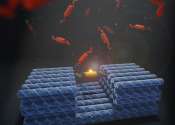Autonomous nanomachines inspired by nature
Inspired by the way molecules interact in nature, UNSW medical researchers engineer versatile nanoscale machines to enable greater functional range.

Inspired by the way molecules interact in nature, UNSW medical researchers engineer versatile nanoscale machines to enable greater functional range.
Bio & Medicine
Mar 23, 2022
0
100

When something goes wrong during DNA replication, cells call their own version of 911 to pause the process and fix the problem—a failsafe that is critical to maintaining health and staving off disease.
Cell & Microbiology
Mar 21, 2022
0
35

One fundamental question in the field of the Origin of Life is how the first molecules of DNA replicated and evolved on the primordial Earth, more than 4 billion years ago. Before the emergence of the first cells or any other ...
Evolution
Mar 21, 2022
0
229

For cells to thrive, a complex network of three-dimensional structures assembles to read, copy and produce the genetic materials (DNA) needed for cellular function. Understanding how these structures form, and what happens ...
Cell & Microbiology
Mar 10, 2022
0
110

Scientists in Japan have made a tuneable, elastic and temperature-sensitive gel by using complementary DNA strands to connect star-shaped polymer molecules together. The gel, and the method used to develop it, could lead ...
Polymers
Feb 16, 2022
0
28

There are many ways in which the genetic material DNA can be damaged, resulting in the development of diseases such as cancer. Certain forms of DNA damage are associated with so-called R-loops. These are three-stranded structures ...
Molecular & Computational biology
Feb 8, 2022
0
21

Researchers from the Okinawa Institute of Science and Technology Graduate University (OIST) have used microscopic strands of DNA to guide the assembly of gel blocks that are visible to the naked eye.
Biotechnology
Jan 31, 2022
0
100

Growing up is a complex process for multi-celled organisms—plants included. In the days or weeks it takes to go from a seed to a sprout to a full plant, plants express hundreds of genes in different places at different ...
Plants & Animals
Jan 12, 2022
0
32

The use of genetic information is now indispensable for modern plant breeding. Even though DNA sequencing has become much cheaper since the human genome was decoded for the very first time in 2003, collecting the full genetic ...
Plants & Animals
Jan 3, 2022
0
15

Rather than one key and one strong lock, biology often uses tens or hundreds of weaker links to bind parts together, such as cell membranes. This allows for selectivity and also reversibility—the binding can also be undone. ...
Cell & Microbiology
Sep 2, 2021
0
46